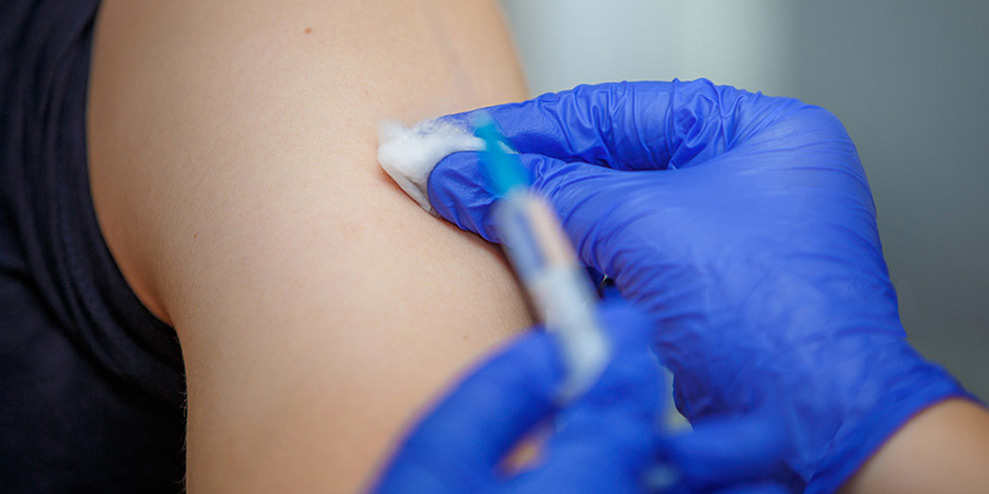Vaccines are a powerful weapon in the fight against disease, but only if they are taken. A team of behavioral scientists at Wharton and Penn is studying the best methods of communication to persuade more people to get off the fence and into their doctor’s offices or local pharmacies to get vaccinated.
The Behavior Change for Good Initiative (BCFG) has partnered with Walmart to conduct the largest-ever study aimed at increasing vaccinations by examining what kinds of messages encourage compliance. Conceived in March, the study was originally designed for the 2020 flu season, just as the coronavirus pandemic was sweeping the country with exponential growth.
“We realized with the COVID-19 outbreak that there was a much bigger challenge we could try to help tackle,” BCFG co-director Katy Milkman said. “If we could use the opportunity of flu season to test what really encouraged vaccination in a way that might be portable to the COVID-19 vaccine, we could make a really big, positive impact. So, we scaled up our ambitions quite enormously.”
Milkman is a professor in Wharton’s operations, information and decisions department and holds a secondary appointment at Penn’s Perelman School of Medicine. She led the study along with Wharton professors Mitesh Patel and Angela Duckworth.
The scholars created a tournament, inviting over 125 world-renowned behavioral scientists on the BCFG scientific team to submit their best messaging strategies to nudge people from intention to action. The competition yielded 75 submissions, which were further narrowed to 37 fielded tests, and the results of the study will be finalized in a few weeks and released in late 2020 or early 2021. Milkman joined the Wharton Business Daily radio show on SiriusXM to discuss the study as the world anxiously awaits the release of a COVID-19 vaccine, which government officials said could happen as soon as mid-December. (Listen to the podcast at the top of this page.)
The Last Mile
There has always been reluctance around vaccines — a skepticism has been fueled in recent years by the anti-vaxxer movement that has spread through misinformation on social media. Some people are nervous about the safety and efficacy of three COVID-19 vaccines being produced by pharmaceutical companies Pfizer, Moderna and AstraZeneca because the government has fast-tracked approval. In an encouraging sign, monthly polls have shown an increase in Americans’ willingness to take a COVID-19 vaccine since September, although the numbers are still just below 60% and lower than they were last spring.
“What that means is that those people [are]interested in the vaccine at a high level, and they’re persuadable,” Milkman said. “They’re not strong anti-vaxxers, but they need to feel like it’s going to be safe. And if they’re not sure or they’re a little hesitant, we need to make it as easy as possible and as appealing as possible so that they do get the vaccine, so that we can achieve herd immunity.”
Milkman said many people have every intention of getting vaccinated, but they procrastinate or simply don’t follow through. Closing that gap between intention and action is key, and something Milkman has studied for years. She calls it “the last-mile problem,” a business term that refers to the final hurdle standing between consumers receiving products or services.
“We’re pretty convinced [a vaccine]is probably a good idea. We have a little hesitation. Hassle factors, or the sense that, ‘Oh, this is going to be kind of unpleasant,’ can get in the way if we don’t get the communications right,” Milkman said.
Getting the Message Just Right
A few of the messaging strategies in the study really stood out to Milkman. One was created by BCFG team member Gretchen Chapman, a psychology professor at Carnegie Mellon University who is also a member of the Penn Center for Health Incentives and Behavioral Economics.
In a previous study on flu shots, Chapman randomly assigned subjects to receive a message from their employers with information about a walk-in clinic and inviting them to book an appointment. Others received a message that their employers had already booked an appointment for them at a specific date and time, but it could be rescheduled.
“We’re going to need to understand what’s holding someone back, what sub-populations have different concerns, and try to tackle those things.”–Katy Milkman
The message with a specific appointment time “increased vaccination rates dramatically,” Milkman said, so Chapman tried a related approach in the BCFG study, letting people know that a vaccine had already been reserved for them specifically.
The BCFG study tested dozens of additional ideas designed by other team behavioral scientists including asking people to commit in advance to getting a vaccine, sending reminders to people minutes before they’d have a chance to get vaccinated, and asking participants to message their family and friends to get vaccinated.
“By essentially turning you into a proselytizer for the vaccine, it can change your own psychology and your own likelihood to go, as well as helping encourage your friends and family,” Milkman said.
The team even tried ramping up friendly competition between cities, like pushing Pennsylvanians to beat New Yorkers on vaccination rates, for example. The goal of so many different approaches is to find what works best for each group of consumers and tailor messages accordingly.
“We’re going to need to understand what’s holding someone back, what sub-populations have different concerns, and try to tackle those things,” Milkman said.
Scientists are charging ahead to make a COVID-19 vaccine available, working out the challenging logistics of wide-scale production and distribution. Milkman is hopeful that the work of the BCFG team will, in turn, help more people take the vaccine.
“Even if we get the supply chain issues right, even if we get every corner drugstore to someday be supplying these, we have to get them into arms in order for them to change the course of the pandemic,” she said. “And the messaging is going to be key to that.”




